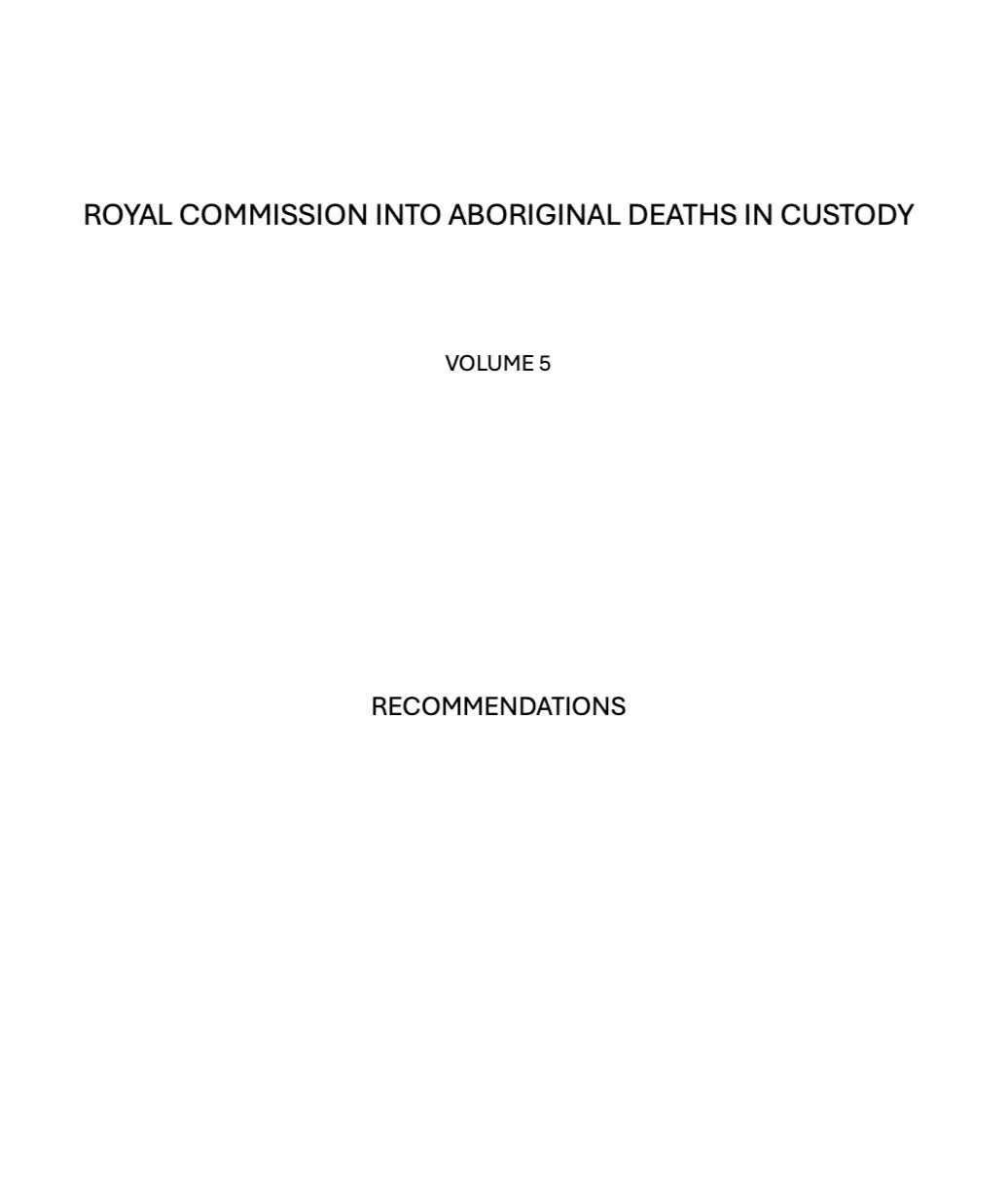5. Time For A New Path
The Royal Commission Into Aboriginal Deaths in Custody (RCIADIC) Recommendations are not enough.
The Recommendations of the Royal Commission into Aboriginal Deaths in Custody (RCIADIC) were handed down in 1991, with the purpose of addressing concerns about the increasing number of Aboriginal Deaths in Custody and determine whether there were correctional practices that were contributing to this. The Commission never formally had the brief to address over-incarceration.
However, early in it’s inquiry the Commission concluded that:
‘Aboriginal people in custody do not die at a greater rate than non-Aboriginal people in custody … what is overwhelmingly different is the rate at which Aboriginal people come into custody, compared with the rate of the general community’.
The Commission, within its resource and time constraints, attempted to respond in some part to the issues shaping over-incarceration, but were only able to do so in quite general terms.
Of the 339 recommendations in the RCIADIC report over 50 recommendations looked at improving in-prison practices.
Many of the recommendations that related specifically to reducing deaths in custody have been substantially implemented, bringing both some improvements and some bad news. In the 27 years following the release of the Royal Commission report, the mortality rate for Aboriginal and Torres Strait Islander people in custody has halved. However, over the same time, the Aboriginal and Torres Strait Islander share of the prison population has more than doubled and continues to rise. Net effect, no improvement.
In fact, there are now more Aboriginal deaths in custody than there were at the time of the Royal Commission.
In 2023-24 there were 24 Indigenous deaths in custody. Roughly half of the deaths were deemed from natural causes while nearly half were from hanging and related complications.
The RCIADIC also made more general recommendations about improving community-based responses. While these recommendations are sound most are too general for anyone to be held to account to deliver on them.
Over 100 of the recommendations relate to social and community measures that require a foundational shift in the way we respond to many of the determinants of incarceration.
The RCIADIC was a deeply important consultation process and a genuine conversation between the government of the time and the Indigenous people of Australia. Its report included ground-breaking observations and recommendations that remain relevant today, not only about deaths in custody but the broader issues surrounding Aboriginal incarceration. But after thirty years of partial implementation the situation has not improved for Aboriginal families.
Advocates across the country have continued to call for the full implementation of all 339 recommendations. However, it’s highly questionable that the document still has political currency or that the recommendations provide the targeted solutions we now need.
A federally commissioned review of the implementation of the RCIADIC recommendations conducted in 2018 by Deloitte Access Economics concluded that 78% of the 339 recommendations have been fully or mostly implemented and that 91% of the recommendations for which government has some responsibility had been satisfactorily implemented.
This finding has been strongly challenged by many Indigenous leaders including in a 2021 critique by the Centre for Aboriginal Economic Policy Research who expressed concerns about the methodology and data sources used by the review, stating that it obscured whether any of the responses taken had actually achieved any positive outcomes.
A lot has happened since the release of the RCIADIC report. There are potential solutions and ways of thinking now that were not readily available to the Commission in the early 1990s.
Collectively, we have learned a lot about better justice since then, even if we haven’t applied it widely in Australia.
We have better understandings of neurocognitive development and its effects on young people.
We know more about the ways that mental health issues and acquired brain Injury affect people and can impact justice involvement; we have better ways of treating these conditions in the community.
We have learned about the impacts of trauma in shaping the lives of those we imprison.
We have more information about the positive achievements and constraints of therapeutic jurisprudence, solution-focused courts, Koori Courts, Restorative Justice and Justice Reinvestment as applied in Australia.
We have successful western European models with low incarceration, low crime rates and high community safety to draw on.
Perhaps we also better understand the intentional role of the colonising voices in Australian politics that sustain Aboriginal over-incarceration.
The point is that now, 30 years on, there are countless ways available to us to do better. No longer is it OK just to try to make prisons safe for Aboriginal people. We are long overdue for a re-think of how we do justice, how we can keep Aboriginal people out of prison and reduce the damage that prisons do to so many Aboriginal people, their families and our Australian society.
Our current approach is piecemeal and half-hearted.
Justice is always political. It is governments who need to shape the policies and lead the change, but we, the Australian people need to demand the change.
Our federal government defers to the states, saying that each state and territory determines their own justice policies, but extreme Indigenous incarceration is an issue shared in every state and territory. It is a national responsibility to lead the vision and the concrete actions to right this wrong.
Also of major significance, is that while incarceration is a justice responsibility, most of the solutions lie with health and social services, particularly the Aboriginal Community-Controlled sector and programs like the National Disability Insurance Scheme, sectors that are mostly federally funded.
Together, we need to chart the way forward in clear terms.
We need a new way forward.
https://www.austlii.edu.au/au/other/IndigLRes/rciadic/national/vol5/5.html
https://www.niaa.gov.au/resource-centre/review-implementation-royal-commission-aboriginal-deaths-custody
https://www.aic.gov.au/sites/default/files/2024-12/sr49_deaths_in_custody_2023-24.pdf
https://caepr.cass.anu.edu.au/research/publications/30-years-royal-commission-aboriginal-deaths-custody-recommendations-remain

